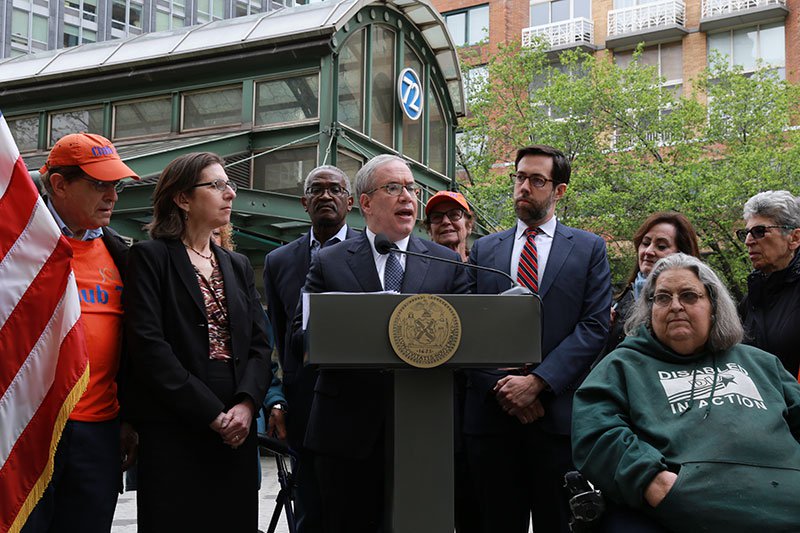Stringer Audit Reveals Serious Gaps in MTA’s Maintenance and Repair of Elevators and Escalators

Nearly 80 percent of sampled machines did not receive all scheduled preventive maintenance
MTA does not ensure needed repairs are made, threatening accessibility and safety
New York, NY – New Yorkers frequently see breakdowns of the MTA’s elevators and escalators, and a new audit released today by New York City Comptroller Scott M. Stringer explains why. The audit found the New York Metropolitan Transportation Authority (MTA) did not perform all scheduled preventive maintenance on nearly 80 percent of the sampled escalators and elevators, and that one-third of the MTA’s scheduled preventive maintenance assignments in the sample were completed late – if at all. In addition, the MTA does not systematically track whether and how quickly all of the defects found in its elevators and escalators are corrected. The MTA’s failure to adhere to its own maintenance schedule and ensure that all defects are promptly corrected can pose safety risks for straphangers and threaten accessibility in subway stations, posing extraordinary challenges particularly for seniors and people with disabilities.
“New Yorkers constantly see and experience broken elevators and escalators – and this audit shows us why it’s happening. Preventive maintenance is late or not happening at all, and when defects are identified, work orders aren’t always created. It’s not rocket science – it’s common-sense. If we aren’t proactively servicing these machines, and if we aren’t repairing them when we find problems, they’re going to break down. New York City Comptroller Scott M. Stringer said. “When seniors and people with disabilities can’t get to where they need to go because of a broken elevator or escalator, government is failing them. This audit isn’t just about basic maintenance. It should be a reminder that behind every broken machine, behind every motionless escalator or elevator, there are people who can’t travel. There are New Yorkers who can’t make it to a job interview or doctor’s appointment. It’s unfair – and it’s gone on for far too long. It must get fixed.”
Even though proactive, preventive maintenance is critical to ensure that elevators and escalators function properly, the Comptroller’s audit shows that preventive maintenance isn’t being completed on time. The Comptroller’s Office sampled 36 elevators and 29 escalators throughout New York City – a total of 65 machines – and found that:
- Approximately 80 percent of the elevators and escalators did not receive all of their scheduled preventive maintenance service assignments.
- 21 of the 65 machines – or 32 percent of the sample – failed one or more of the MTA’s own inspections and were removed from service to address the safety defects.
- 15 of the 21 machines that failed inspection had been serviced approximately two weeks before the inspection.
- Those 15 machines had 62 defects that remained pending even after they were serviced.
The 65 sampled elevators and escalators should have received 849 scheduled preventive maintenance services during an 18-month period the Comptroller’s Office audited. However, of those 849 preventive maintenance assignments:
- 34 percent – 289 of the 849 assignments we sampled – were not completed on time or at all;
- 164 maintenance assignments performed, or 22 percent, were not completed on time. The vast majority were late, by 15 days on average, with 60 taking even longer;
- 21 maintenance assignments were not completed at all.
- 104 maintenance assignments were canceled (with an explanatory memo on file). However, 32 of those memos did not meet the MTA’s own criteria for canceling preventive maintenance.
New York City Transit’s (NYCT) Division of Elevators and Escalators, which is part of the MTA system, is responsible for the maintenance, repair, and inspection of the elevators and escalators located throughout the subway system. Checklists are used to specify what areas of the machines need to be inspected or serviced, depending on the level of preventive maintenance or inspection to be performed.
However, the Comptroller’s office found that, in many cases, work orders were never created, even after new defects were found during preventive maintenance or inspections. After analyzing 949 preventive maintenance and inspection checklists, the audit found 331 checklists in which new defects were noted. Yet, for one in four of those cases on average—or 89 total—the auditors found no evidence that work orders were ever created to fix the problems cited. That means some defects identified during preventive maintenance and inspections were not addressed on time, if at all.
In addition, NYCT does not track when or even whether all defects have been corrected. NYCT’s database does not have a dedicated data field in which specific defects that need to be corrected can be listed.
As a result of these breakdowns in process, NYCT’s ability to ensure that its 407 elevators and escalators are operating in good condition is hindered.
To correct the wide range of shortcomings in the MTA’s preventive maintenance regimen, the Comptroller’s Office made 13 recommendations, including setting realistic internal targets for preventive maintenance service assignments, reinstructing all personnel on their responsibilities for completing and approving checklists, and instituting rigorous procedures for ensuring work orders are created and every defect identified is addressed.
“Elevators and escalators are the first and last stop for many subway riders — but too often the last priority for the MTA,” said State Senator Daniel Squadron. “I’ve seen busted deadlines and broken escalators repeatedly in my own district, from the East Broadway F, to the High Street A/C and beyond. I urged a review because functioning infrastructure and timelines in the system are often as elusive as functioning escalators and elevators. Thank you to Comptroller Stringer for completing this review, as well as my colleagues and the advocates here today.”
To view the full audit, click here.
###